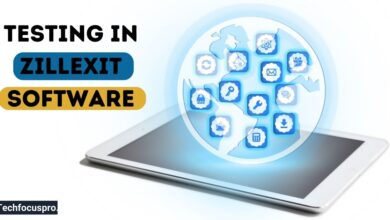Evolution and Importance of Software in Daily Life

In the modern era, software has become an integral part of our daily lives, powering everything from smartphones to complex industrial systems.
As technology advances, software’s role in shaping industries, businesses, and personal activities has grown exponentially.
Understanding software’s evolution, types, and significance helps us appreciate its impact on our digital world.
Evolution of Software
1. The Early Days of Software Development
The evolution of software can be traced back to the mid-20th century, starting with the advent of early computers. Software programs were written in binary or machine code during this era, directly communicating with the hardware.
These programs were basic, had limited functionality, and required significant expertise to create and maintain. Early pioneers like Ada Lovelace, Alan Turing, and John von Neumann laid the groundwork for modern computing and software logic.
Read More: How Much Does Custom Software Development Cost
2. The Introduction of High-Level Programming Languages
The 1950s and 1960s marked a significant leap forward, introducing high-level programming languages such as FORTRAN, COBOL, and LISP.
These languages made it easier for engineers to write code using more human-readable syntax, reducing the complexity of software development.
This period also saw the rise of compilers, which translated high-level code into machine code, making software development more efficient.
3. The Era of Personal Computing
The 1970s and 1980s brought the era of personal computing, which revolutionized the software industry. Companies like Microsoft and Apple introduced operating systems like MS-DOS, Windows, and macOS, enabling users to interact with computers through graphical user interfaces (GUIs).
Software applications became more consumer-focused, and the industry boomed as it catered to businesses and individuals.
4. The Rise of the Internet and Open Source
The 1990s heralded the rise of the internet, which transformed software development and distribution. Developers could now collaborate globally, and the open-source movement gained traction with projects like Linux and Apache.
Open-source software encouraged community involvement and innovation, creating a culture of shared development and accessibility.
5. The Age of Mobile and Cloud Computing
The early 2000s saw the emergence of mobile computing and cloud-based solutions. Smartphones and tablets opened new possibilities for application development, with mobile operating systems such as iOS and Android dominating the market.
Meanwhile, the cloud-enabled software will be delivered as a service (SaaS), making it more scalable and accessible through web browsers.
6. Artificial Intelligence and Future Directions
Today, software is deeply integrated with artificial intelligence (AI) and machine learning (ML), leading to more intelligent, more adaptive applications. From virtual assistants to predictive analytics, AI-powered software continues to transform industries.
Looking ahead, software development is poised to capitalize on advancements like quantum computing, augmented reality, and blockchain technologies, paving the way for an even more interconnected and innovative future.
The evolution of software highlights the constant cycle of innovation and adaptability, shaping the world as we know it. With each new development, software expands its capability to enhance human productivity, creativity, and connectivity.
Read More:- How AI is Revolutionizing Workforce Management
Importance of Software in Daily Life

Software is essential in nearly every aspect of modern life, making it an indispensable part of our daily routines. It enhances efficiency and convenience in everything from communication to healthcare, education to entertainment.
For instance, messaging apps, social media platforms, and email services have revolutionized communication, enabling instant connectivity worldwide.
Similarly, healthcare software applications power diagnostics, manage patient records and support life-saving surgeries with robotic assistance.
Software has also transformed education through e-learning platforms, virtual classrooms, and interactive tools that make learning more accessible and engaging.
Workflow management software enables businesses to operate more efficiently, automating tasks and facilitating collaboration among teams, especially in remote work environments.
Furthermore, entertainment software, such as streaming services, video games, and music apps, provides people with endless options for leisure and relaxation.
Software innovations have simplified everyday tasks like shopping, banking, and navigation. Mobile apps allow users to purchase goods and services, transfer money, or find directions with a few taps.
Household devices, from smart thermostats to voice assistants, rely on software to enhance functionality and convenience. Software’s ubiquity underscores its importance in creating a connected, efficient, and increasingly automated world.
It is a driving force behind the advancements that shape modern life, and it is crucial for both personal and professional spheres.
Challenges of software into daily life

While integrating software into daily life has brought numerous benefits, it also presents various challenges and considerations that must be addressed. One of the most pressing challenges is ensuring data security and privacy.
With the increasing reliance on software, vast amounts of personal and sensitive information are being collected and stored, making individuals and organizations vulnerable to cyber threats and data breaches.
To safeguard user information, developers must prioritize robust encryption, regular software updates, and compliance with data protection laws.
Another significant consideration is accessibility. Not all individuals or communities have equal access to the technologies required to utilize software effectively.
Digital inequality, driven by economic disparities and lack of infrastructure, creates a gap between those who benefit from advanced software tools and those who do not. Bridging this divide requires deliberate efforts, including investment in affordable technologies and educational resources.
Additionally, software development often faces technical and logistical challenges. Developers must ensure compatibility across multiple platforms, meet user expectations, and maintain scalability and reliability.
These challenges are further compounded by the rapid pace of technological evolution, which often necessitates constant updates and adaptations.
Finally, ethical considerations surround software usage, especially in artificial intelligence and automation. Questions about bias in algorithms, the displacement of jobs, and the overarching impact of automation on society are increasingly relevant.
As software continues to shape the world, ethical frameworks and innovative solutions will be essential to balance progress with responsibility.
Future of Software

Advancements in artificial intelligence, cloud computing, and quantum technologies are poised to shape the future of software. AI will continue to drive innovation, enabling software systems to become increasingly intelligent, adaptive, and capable of performing complex tasks autonomously.
Cloud computing is expected to enhance scalability and accessibility, allowing businesses and individuals to access robust software solutions from virtually anywhere.
Meanwhile, the emergence of quantum computing holds the potential to revolutionize software development by solving problems that are currently computationally infeasible.
Additionally, the rise of no-code and low-code platforms may democratize software creation, empowering more people to build customized solutions without extensive programming knowledge.
However, addressing cybersecurity risks and ethical implications will remain paramount as technology evolves. The future of software will likely be defined by a balance between groundbreaking innovations and the responsibility to ensure that these advancements are used effectively and equitably.
FAQs
What is the evolution of software?
The evolution of software traces back to the early days of computing when simple assembly language programs were developed to execute basic tasks. Over time, programming languages advanced, and software became more complex, leading to the creation of operating systems, application software, and enterprise solutions.
Today, software has become a crucial driver of industries, personal productivity, and interconnected ecosystems powered by artificial intelligence, cloud computing, and automation.
Why is software essential in daily life?
The software enables the functionality of daily devices and systems, from smartphones and computers to household appliances and vehicles. It simplifies communication, automates tasks, manages data, and provides tools for both personal and professional use.
Whether for education, healthcare, entertainment, or business, software is indispensable in improving efficiency and enhancing the quality of life.
How has software impacted businesses?
Software has revolutionized businesses by streamlining operations, enhancing productivity, and enabling data-driven decision-making.
Companies utilize software for resource management, customer relationship management (CRM), marketing automation, and online services.
The integration of software has also helped businesses adapt to global markets and create innovative products faster.
Can software influence personal development?
Yes, software tools have become essential for personal development. Educational apps, productivity tools, and health trackers help individuals acquire skills, manage time, and maintain well-being.
Furthermore, the software facilitates access to online courses, self-help platforms, and creative outlets, empowering users to reach their personal goals effectively.
How does software support modern communication?
Software underlies all modern communication systems, including messaging apps, video conferencing platforms, and social media networks.
It enables instant connectivity worldwide, allowing people to collaborate, share information, and maintain relationships regardless of geographical boundaries.
What is the future of software in daily life?
The future of software promises continued innovation with emerging technologies such as AI, machine learning, augmented reality (AR), and the Internet of Things (IoT).
These advancements will further enhance efficiency, personalization, and convenience, shaping a world where software is seamlessly integrated into every aspect of life.
Conclusion
The conclusion of this document encapsulates the key points discussed throughout, emphasizing the dynamic and rapidly evolving nature of software development. It highlights the significant role emerging technologies, such as artificial intelligence, cloud computing, and quantum computing, play in shaping the software landscape. Additionally, it underscores the democratization of software creation through no-code and low-code platforms, making technology more accessible to a broader audience. Notably, the conclusion also serves as a reminder of the critical responsibility to address challenges such as cybersecurity and ethical considerations. Ultimately, it reflects on the exciting potential of future software advancements, coupled with the need to channel innovation towards sustainable, equitable, and secure solutions for society.






